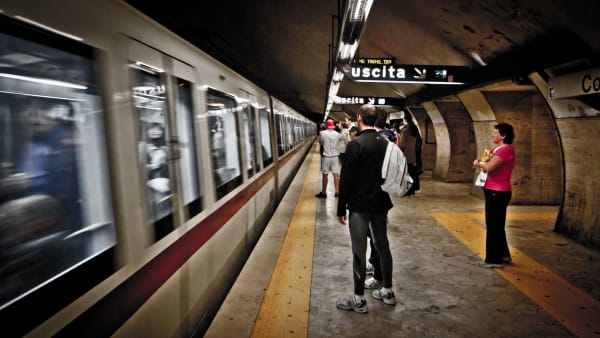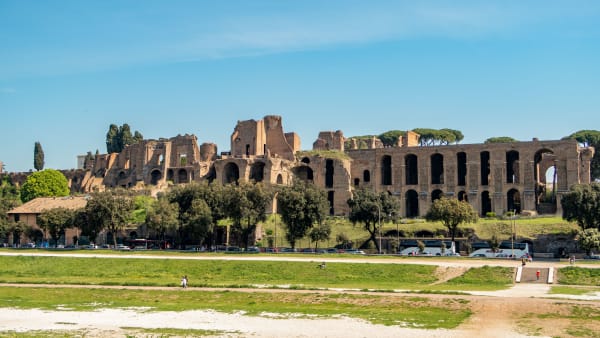Nearby places of interest
Nearby places of interest
Due to its favorable location, many tour operators combine a visit to the Domus Aurea with a trip to the Roman Forum or the Colosseum. The ruins are also surrounded by a park where you can picnic or take a walk.
Here is an overview of all the attractions that are near Domus Aurea.
Roman Forum
This was the epicenter of social, political, religious, and cultural life in ancient Rome. It was also the heart of the empire and the ruins found here are surprisingly interesting.
No trip to the Eternal City would be complete without a visit to this majestic complex. It’s a must-see site and access is included in the Colosseum entry ticket .
From the Domus Aurea, it’s only an 8-minute walk to the Roman Forum (550 m).
Palatine Hill
The Palatine is one of the seven hills of Rome and the first that was inhabited. Since the imperial period, it was the hill where the emperors built their palaces.
Here you can visit, among others, the remains of the residences of the House of Augustus, the Domus Tiberiana, the House of Livia, the Domus Aurea, the Farnesian Gardens, the Domus Transitoria, and the Hut of Romulus.
Palatine Hill is only a 15-minute walk from the Domus Aurea (950 m). The Palatine Museum is exactly 1 kilometer from Nero’s Golden House.
Arch of Constantine
Among the three Arches of Triumph that still exist in Rome, this is the best-preserved one. The striking monument was built in the early fourth century to commemorate the victory of Constantine I at the Battle of Milvian Bridge in 312 AD.
It’s the last great monument of Imperial Rome and was inaugurated on the 10th anniversary of Constantine’s reign. It’s an imposing 21 meters high and 25.6 m wide and stood on Rome’s triumphal route.
The Arch of Constantine is located next to the Colosseum and just 700 meters from the Domus Aurea (an 8-minute walk).
Imperial Fora
The Fori Imperiali consists of a series of monumental fora (public squares). They were built over a total period of 150 years, between 46 BC and 113 AD. Over the years, Caesar, Vespasian, Augustus, Nerva, and Trajan contributed to its development.
The Imperial Fora were built to replace the Roman Forum after it became too small due to strong population growth and could no longer fulfill its purpose as the center of Rome.
The entrance to the Imperial Fora is 1 km northwest of the Domus Aurea (a 15-minute walk).
Circus Maximus
Considered to be the largest sports stadium built by man, this archaeological area was the site of legendary entertainment activities for nearly a thousand years.
Most of the building is underground and there’s not much left to see above ground. However, through a virtual reality tour , you can discover what the circus used to look like. It’s definitely worth a visit.
The entrance to the Circus Maximus is located 700 m south of the Colosseum. From the Domus Aurea it’s a 20-minute walk away (1.6 km).
Ludus Magnus
The Ludus Magnus was the largest of the four ludi (gladiatorial schools) known from ancient Rome. The rectangular building complex was commissioned by Emperor Domitian (81-96) and completed by Hadrian (117-138).
The building was located in the valley between the Caelius and the Esquiline, east of the Colosseum—to which it was connected by a subterranean passage.
From the Domus Aurea, it’s a 10-minute walk through the Oppio Park until you pass Piazza Colosseo and see the ruins of the Ludus Magnus.
Basilica of San Clemente
This intriguing building complex is a Roman Catholic church dedicated to Pope Clement I. The first tier was built in the fourth century, making it one of the oldest Christian churches in Rome.
Over the centuries, three successive floors have been built over it, of which the top three can be visited. During a visit, you can admire (among other things) the underground temple of the Persian sun-god Mithras and numerous medieval frescoes.
The Basilica of San Clemente is less than 1 kilometer from the Domus Aurea. Depending on the route you take, you can walk past the Colosseum and the Ludus Magnus, or take a nice long walk through Oppio Park to get to the Basilica.















